-
Posts
617 -
Joined
-
Last visited
-
Days Won
1
Content Type
Profiles
Forums
Blogs
Gallery
Events
Store
Posts posted by 2dresq
-
-
Greetings, I am curious how much these are fetching these days. I have just purchased a nice Air Crew set for $400 USD.
I think I got a deal on it. However, I wanted to get a general response from the members here: What are the campaign stars period issue going for?
Atlantic
France and Germany
Italy
Pacific
Burma
Aircrew
Africa
Regards,
JustinG
2dresq
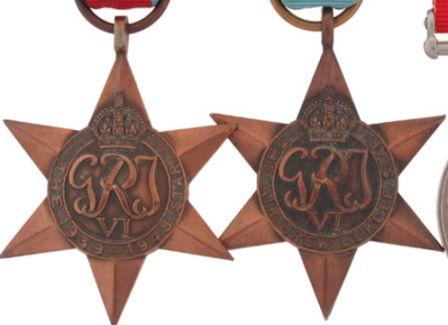 0
0 -
So, I think I now understand, The Pembroke tallies listed above, there are two with stops/period mark after the ships name. this indicates that it was a pre war piece. So those are the only two of the long list that are pre-war?
Am I correct in my assumption? Since the naval unit you listed was in use for the span of the first and second world war, is there a construction difference or different material to help place the tally from the first vs the second world war? Was it only after the second World War that the Royal Navy decided to change their tradition of putting punctuation marks after the named unit?
This is fascinating stuff. I am grateful and do wish to learn more.

Thanks.
Regards,
JustinG
0 -
I appreciate the in-depth report. So, I am not seeing the stop difference. When I compare the (period) in the H.M.S. I am having a hard time seeing the difference. I am very new to the field of Royal navy items.
From your description, Post war to 1960's having a "fat stop" I am assuming that all these tallies that you have shown in the post above are post war and up to the 1960's. Am I correct in my assumption.
It is difficult to tell since the resolution on this forum must be reduced. When I look at the tallies: Roebuck, Rooke and Raleigh the threads seem to be at a angle going diagonal for the weave; is this so?
I appreciate the details you have posted. It is very informative. It seems like the British had several landmines set for collectors of their naval hat insignia.
I look forward to hearing more.
Cheers,

JustinG 2dresq
0 -
HMS Rodney
Thanks for looking. The Ajax and Rodney kind of washed out a bit with the scan. They do have a yellow color to them.
And as always, any and all comments are welcome. I will post some scans of the reverse tomorrow.
Cheers,
JustinG
2dresq
0 -
double post. Sorry.
 0
0 -
-
-
So here's some of the tallies I received. HMS Exeter
Regards,
JustinG
 0
0 -
There are many details from which pre and post war tallies can be recognized. Most significant are the length of the text (or the with of the letters) and the size of the dots. In general I hold the narrow letters and the narrow dots for the oldest. Post war tallies lack the dots after the ship's name. But also the (colour of the) material can be an indication.
Tallies were produced by various contractors, thus in the shape and details of letters ther can be differences (look at the R).
As stated above, it is a complicated matter, which takes a lot of experience that cannot be learned from just reading about it. One has to take time, rely on older and more experienced collectors (as I am indebted to old guys long gone) and a keen eye for details.
Enclosed some tallies of HMS PEMBROKE (RN Barracks in Chatham), built 1901 and closed 1976. Tallies with this name have been used for 3/4 century, and see the differences...
Also, it helps to use your whits and Janes or other reference books to date ship's/establishment's names.
Still specific differences can be told easily such as ryon lettering which was used in the 1940s and 50s, the new bling gold from the 1980s, and other features.

This is turning to be exactly what I am wanting. With regard to the "dots", am I correct in my assumption that it refers to the holes left where the stitching goes back and forth within the various letters and punctuation?
Quite an interesting study. I have been focused for so long on Kriegsmarine tallies and have now just started venturing out to the Royal Navy. I am expecting the 4 tallies purchased to arrive here some time soon.
Posted is an example of what I am assuming I have understood regarding the "dots".
This is a WW1 Naval German battery division
Thank you for your explanation.
Regards,
JustinG 2dresq
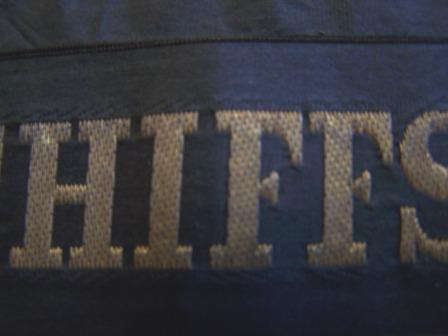 0
0 -
Thank you for posting.
The variations really are quite different. The British seemed to have a much looser standard than other countries. The Sea Cadets and HMS Marlbourough would be considered fake on construction alone if they were German made. The German liner is interesting. I only own 3 German Passenger ship talllies: The KdF W.Gustloff, Cap Arcona, and KdF Robert Ley. Never seen a muetzenband with the double words above and below. Thanks for sharing.
So, is there construction standard for HMS warships for the pre WW2 and WW2 era that was followed?
The Germans Strictly removed the named muetzenbands when the war started to protect the secrecy and prevent spies from being able to identify what ships were in port, and so, they went to the standard Kriegsmarine labeled muetzenband/tally; did the British do the same thing with the solo H.M.S labeling? I have seen a couple of these around.
Thank you for your time. Very interesting stuff.
Oh, Here's a reverse shot of the KdF ship. Wilhelm Gustloff which of course, was the worst maritime single loss of life ever.
 0
0 -
Could you post reverse stitching of one of your tallies please.
Regards,
JustinG
0 -
I agree. The back construction looked good. However, I was aware. I didn't pay too much. A study of construction would be very helpful though. Here's a close up of the stitching of a German Kriegsmarine tally.
The one showing the reverse is Metalfaden thread. the lower obverse is cellon construction. Both are of the Panzerschiff Deutschland
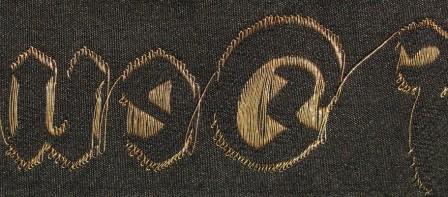
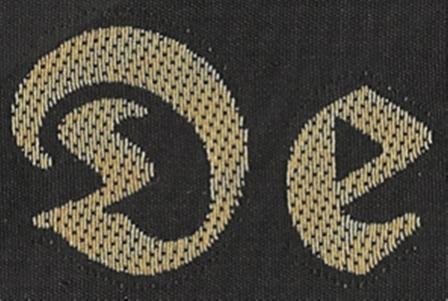 0
0 -
This is very nice. Thanks for sharing. I purchased four tallies: HMS Ark Royal, HMS Rodney, HMS Ajax and HMS Exeter. These are of course all very well known ships. I purchased them from a reputable dealer. When they finally arrive in my hands I will post scans/photos of them. Hopefully, the dealer will continue in my eyes, to be reputable.
 I am hoping to make a tribute to the Battle of the River Plate. So, I need the Achilles and perhaps the Cumberland tallies as well. :)0
I am hoping to make a tribute to the Battle of the River Plate. So, I need the Achilles and perhaps the Cumberland tallies as well. :)0 -
Greetings,
I am looking at acquiring some Royal Navy tallies. I have studied the German tallies and have made a practice of recognizing a good one of these. However, with the Royal Navy, since several ships have been commissioned with the same name as some WW1 and WW2 names. Is there a method of how to detect if this tally is a period WW2 item or if it is post war?
Thanks,
JustinG 2dresq
0 -
Could you take a shot of the rather large wimple displayed. I have never seen one that large before.
Everyone has already said it. This is a magnificent collection.
Regards,
JustinG
0 -
-
I don't have a U-flottille Weddigen spare. I only had a spare Unterseeboot schule tally.
www.weitze.net has three currently for sale.
Here's a link for the 300 version. Pretty nice condition.
https://www.weitze.n...__144983_e.html
Regards,
JustinG
0 -
I am truly sorry to hear about your wife and your misfortune. That is a very touching thing she did getting you that Scharnhorst tally. It looks in incredible condition.
As for price, That was quite a nice bargain price IMO. A tally like this generally goes for around 200-250 Euro, some dealers have them listed for 300 Euro.
You got quite a deal with this one. A nice Panzerschiff one from the Admiral Scheer and Deutschland are more available than period Admiral Graf Spee which can run into bigger bucks since they are more coveted.
The Schlachtschiff muetzenbands are limited and don't turn up as often. The Scharnhorst is more common to find, than the Gneisenau.
This is a great looking muetzenband and will hold special significance since it was a gift from your wife. (She did good
 )
) Best of luck to you and your family and congratulations on acquiring such a nice tally.
Regards,
Justin
2dresq
0 -
Justin,
You only need the Mosel to complete your U-Boat set, there were no ribbons for the Kophamel, Bauer or Wünsche
Good to know: Thanks!

Regards,
JustinG
0 -
So I have added two other additions: A metalfaden version of the Linienschiff Hannover and I got the U=begleitschiff Erwin Wassner.
So, These are the ones I have remaining:
Unterseebootstender Mosel
U=Begleitschiff Waldemar Kophamel
U=Begleitschiff Otto Wuensche
U=Begleitschiff Wilhelm Bauer.
If any of you come across these, I would be grateful. I am also missing 5 destroyer tallies.

Thanks for looking,
JustinG
 0
0 -
Well, I was finally able to obtain a period Unterseebootsflottille Emsmann muetzenband. That completes the named U-Flottille's.

I am very fortunate.
Regards,
Justin 2dresq
 0
0 -
So Arne, Do you have the photos professionally matted and then place the Muetzenband yourself in position? Do you do this all yourself?
Stunning and quality displays.
Regards,
JustinG
0 -
Very nice buckles.
Regards,
JustinG
0 -
My favorite.

Regards,
JustinG
0



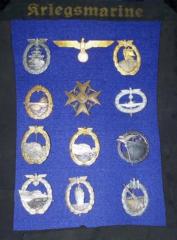


Campaign WW2 stars and their estimated price ranges
in Great Britain: Orders, Gallantry, Campaign Medals
Posted
close up. I don't have this medal grouping yet. By looking at the study here, I believe that this one has all the attributes of a genuine medal.
http://www.northeastmedals.co.uk/britishguide/british_index.htm
This is a wonderful reference site.
Regards,
JustinG
2dresq